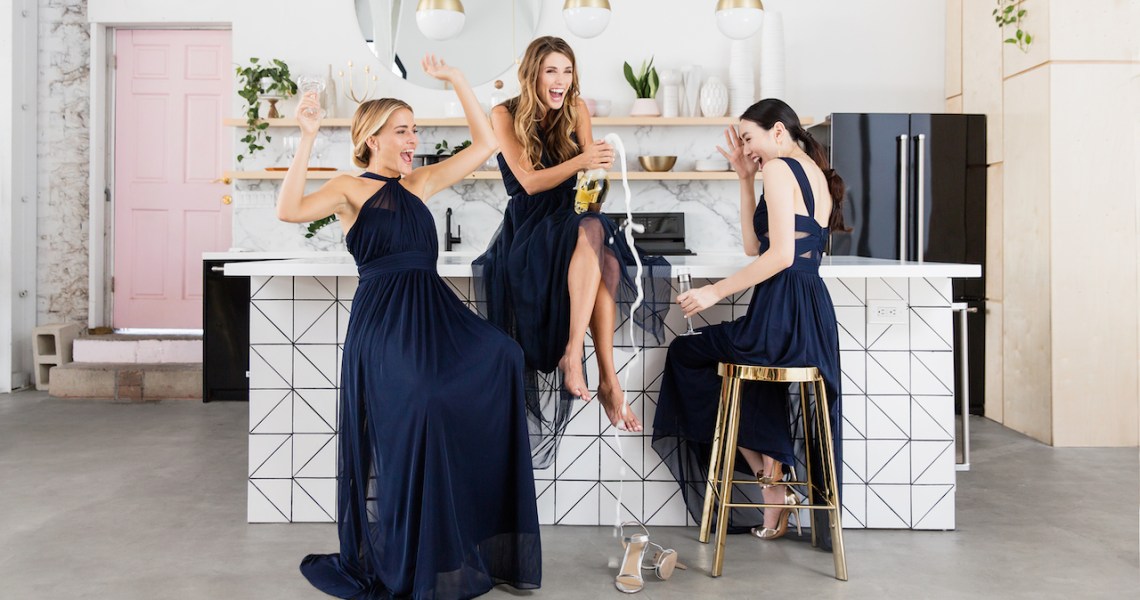Birdy Grey launched in 2017 as an affordable solution for bridesmaids’ dresses, selling dresses in a variety of colors and styles direct to consumers for just $99. From the outset, it decided to go all in on Instagram ads to grow, and grow quickly.
Instagram helped drive $2 million in revenue for Birdy Grey in 2018. Toward the end of 2018, it also started doing paid search, spending $10 a day, but solely to own the keywords Birdy Grey so competitors couldn’t. This year, it added Facebook and Pinterest to its marketing mix.
The proposition of a $99 bridesmaid dress helped the brand gain awareness through word of mouth, said co-founder Grace Lee. The average bridesmaid’s dress was $142 in 2018, per the Knot. Women in higher-spend weddings ($60,000 and above) pay roughly $197, not including costs for alterations.
Lee said the Instagram-first strategy played a big part in getting Birdy Grey to that $2 million in revenue that year.
“These platforms have made both targeting customers and selling products incredibly simple. DTC brands, in particular, have developed strong direct relationships with consumers through Instagram and have upended the retail and CPG industries, which have a lot to learn from these brands. While overall social media ad spend might be increasing, cost-per-click is decreasing because brands are getting better at engaging their communities,” said Tracy David, CMO at social media analytics company ListenFirst.
In 2017, Birdy Grey only did about $25,000 in revenue. “At the time, I was packing and shipping dresses from my living room floor, hand-cutting swatches and monitoring who was coming to the site and what styles they were asking for,” said Lee. “I was doing customer service, too.” At that point the company was just two people. Today, it has 12 workers on staff, including a newly hired head of performance marketing to continue improving the company’s marketing. The company declined to share revenue for 2019.
For the first nine months of 2018, the company spent $10 a day on Instagram, after Lee noticed an uptick in website traffic in January coming off of engagement season. Lee said she knew millennial women scrolled through Instagram for wedding inspiration. Lee had about $60,000 in funding from her family, $25,000 of which went to photo shoots and other startup costs.
For the Instagram ads, Lee posted in-feed images taken from a pre-launch lifestyle shoot — a lot of images of women wearing different styles and colors of the dresses. A former copywriter and journalist, Lee wrote all of the ad copy as well.
Early on, the strategy was to target with the ads any millennial woman who had gotten engaged in the last six months. Lee also looked to some of the big wedding websites and blogs, like The Knot, and targeted ads at women following those accounts on social media.
In the last three months of 2018, as the company started to grow and sales started to pick up, Lee bumped the daily spend up to $35 a day. She tested a few other figures above $10 before landing on $35.
“Every time we turned up the marketing spend by a couple dollars, we would see more meaningful revenue come back,” Lee said. “But as you scale your spend, CPAs do become more expensive. I was fully prepared for that.” She said the company was capping its spend at $4 per bride, operating on the assumption that each bride would drive, on average, sales of 5.5 bridesmaid’s dresses. To date, Birdy Lee has dressed over 90,000 women for 70,000 weddings, meaning about 20,000 women are repeat customers.
Many direct-to-consumer companies are currently rethinking their Instagram and Facebook strategies, citing the rising customer acquisition costs on those platforms. Diversifying their marketing mix is a common solution. Birdy Grey has also expanded its marketing channels, to an extent, but it has found Instagram works best to drive sales.
Moving into 2020, the company will continue to tinker with its Instagram and Facebook spend, and it plans to up its influencer partnerships, which are often with newly engaged bloggers. Currently, Birdy Grey works with about 20 influencers, all unpaid. In the next year, that number will jump to 70. On top of those channels and paid search, the brand also puts some spend into Pinterest — another big platform for wedding inspiration and planning.




